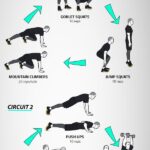Some people prefer interval training because results are faster. This efficient workout method alternates high-intensity bursts with recovery periods to help burn calories, boost metabolism, and achieve your fitness goals in less time.
How Interval Training Stands Out from Traditional Workouts
The world of fitness is constantly evolving, with new methodologies emerging all the time. One such breakthrough in the realm of exercise is interval training. This workout style has quickly surpassed traditional methods, capturing the attention of fitness enthusiasts, athletes, and newcomers alike. But what is it about interval training that makes it so appealing, and how does it distinguish itself from conventional workout routines?

At its core, interval training involves alternating between periods of intense activity and brief rest or low-intensity exercises. This contrasts sharply with the steady, moderate-paced exertion typically associated with traditional workouts, like long-distance running or cycling. To understand the true appeal of interval training, it’s essential to explore how it compares to and ultimately outperforms its traditional counterparts.
The Power of High-Intensity Intervals
Traditional workouts, such as jogging, walking, or swimming at a moderate pace, rely on sustained, steady effort. The body is generally asked to work at a consistent intensity over an extended period, often an hour or more. This steady-state method is effective for improving endurance, but it can be less efficient in terms of calorie burning and overall fitness development.
In contrast, interval training involves short bursts of high-intensity activity followed by a period of rest or low activity. These intense intervals elevate the heart rate significantly, forcing the body to operate at a higher capacity. The result is a workout that not only pushes the body harder but also triggers greater physiological responses in a fraction of the time compared to traditional exercises.

The beauty of high-intensity intervals is that they force the body to adapt quickly. The intensity of the work phase taps into the anaerobic energy system, which is less reliant on oxygen and more dependent on glycogen stores for fuel. This engagement of both the aerobic and anaerobic systems means interval training can help improve endurance, strength, and power all at once—something that steady-state cardio cannot achieve in the same short time frame.
Time Efficiency: Get More Done in Less Time
For many people, time is a precious commodity. Traditional workouts often require a significant investment of time, especially if they are aiming for improved fitness outcomes. Steady-state cardio, like a 45-minute jog, demands a large portion of the day, which may not be feasible for those with busy schedules.
Interval training, on the other hand, is the epitome of time efficiency. A typical interval workout might only take 20 to 30 minutes, yet it delivers far superior results in terms of fat-burning, cardiovascular improvement, and muscle conditioning. The short bursts of intensity maximize calorie burn during the workout itself, while the afterburn effect continues to burn fat for hours after exercise has ended. This makes interval training a compelling choice for anyone looking to fit an effective workout into a tight schedule.
Moreover, the ability to perform high-intensity intervals without sacrificing time has made it a popular choice for individuals looking to maximize their fitness results in the least amount of time. Whether you’re doing sprints, cycling, or strength training, interval training makes it possible to achieve a full-body workout in a fraction of the time, leaving traditional workouts looking inefficient by comparison.
Increased Fat Loss Through EPOC
One of the most notable advantages of interval training over traditional workouts is its ability to promote fat loss through EPOC (Excess Post-Exercise Oxygen Consumption). This phenomenon refers to the increased rate of oxygen intake that occurs after intense exercise, as the body works to restore itself to pre-exercise levels. EPOC leads to a prolonged calorie-burning effect that continues long after the workout ends, making interval training especially effective for fat loss.
Traditional steady-state exercises like jogging or cycling typically do not trigger the same degree of EPOC. While you might burn calories during the session, the post-workout calorie expenditure is relatively minimal compared to interval training. The high-intensity efforts in interval training elevate the metabolic rate significantly, causing the body to continue burning fat for several hours or even up to 24 hours after the session is complete. This afterburn effect gives interval training a significant advantage when it comes to achieving fat loss goals.
Research has shown that interval training can burn more fat in less time than steady-state cardio, making it a preferred method for those aiming to lose weight quickly and efficiently.
Improved Cardiovascular Health and Endurance
While traditional workouts like steady-state cardio are effective for improving cardiovascular endurance, interval training provides a more comprehensive and powerful approach. By alternating between high-intensity bursts and recovery phases, interval training engages both the aerobic and anaerobic energy systems, resulting in superior cardiovascular benefits.
The aerobic system is responsible for sustaining long-term activity and using oxygen efficiently, while the anaerobic system comes into play during short, intense efforts. Interval training forces the body to work in both systems simultaneously, which leads to improvements in both aerobic capacity (the body’s ability to deliver oxygen to muscles) and anaerobic power (the ability to perform high-intensity work for brief periods). This dual focus results in improved overall endurance and a stronger, healthier heart.
In addition, interval training has been shown to increase the efficiency of the body’s cardiovascular system. With regular practice, the heart becomes better equipped to handle fluctuations in intensity, improving its ability to recover quickly after periods of intense activity.
Versatility and Variety in Training
Another key advantage of interval training over traditional workouts is its versatility. While steady-state cardio typically involves a single form of exercise—whether that’s running, cycling, or swimming—interval training allows for a wide range of exercises to be used in the same workout.
Interval training can incorporate virtually any type of activity, from sprinting on a treadmill to cycling, rowing, jumping rope, or even bodyweight exercises like squats, push-ups, and burpees. This variety not only makes the workout more interesting but also helps to target different muscle groups and prevent boredom. In contrast, traditional steady-state cardio often becomes monotonous, particularly when performed over long periods, and many individuals struggle with the lack of variety.
Interval training’s adaptability is another reason for its growing popularity. Whether you’re a seasoned athlete or a beginner, intervals can be tailored to your fitness level. Intensity levels, exercise selection, and rest periods can all be adjusted based on individual goals, making interval training suitable for everyone, from beginners to elite athletes.
Boosting Mental Toughness
The nature of interval training—alternating between intense work and brief rest periods—requires both physical and mental endurance. Unlike traditional workouts, which tend to follow a predictable pattern, interval training challenges the mind to push through moments of intense exertion.
The rapid shifts between high-intensity and low-intensity phases teach the mind to stay focused and resilient, even in the face of physical discomfort. This mental fortitude is something that can be applied not only to fitness but also to other areas of life. Athletes who regularly engage in interval training often report feeling more confident and capable of handling stress and discomfort, both inside and outside the gym.
Conclusion: Interval Training’s Edge Over Traditional Workouts
In summary, interval training distinguishes itself from traditional workouts in several key ways. From time efficiency and fat loss benefits to enhanced cardiovascular health and muscle conditioning, interval training offers a more dynamic and effective approach to fitness. Its versatility allows individuals to tailor workouts to their specific goals, whether those involve losing weight, building strength, or improving endurance.
While traditional exercises like steady-state cardio certainly have their place in a well-rounded fitness routine, the unique advantages of interval training make it a superior option for those looking to get the most out of their workouts in the least amount of time. With its ability to challenge the body and the mind, interval training offers a powerful pathway to improved fitness, fat loss, and overall well-being.
FAQ
Why do some people prefer interval training over traditional workouts?
Some people prefer interval training because it delivers faster results by alternating between high-intensity bursts and recovery periods, helping to burn more calories in less time.
How does interval training deliver faster results compared to other fitness methods?
Interval training maximizes calorie burn, boosts metabolism, and improves cardiovascular health by incorporating intense exercise followed by short recovery, leading to faster progress.
What are the key benefits of interval training for achieving quicker fitness goals?
Key benefits include faster fat loss, increased calorie burn, enhanced endurance, and improved metabolic rate, all of which help people reach their fitness goals more quickly.
Can interval training help with both fat loss and muscle building simultaneously?
Yes, interval training can help with both fat loss and muscle building by providing high-intensity intervals that stimulate muscle growth while burning fat at the same time.
How long should an interval training session be to see the fastest results?
A typical interval training session lasts 20-30 minutes. The key is to ensure high-intensity bursts followed by short recovery periods to keep the metabolism elevated throughout.
What are the main differences between high-intensity interval training (HIIT) and traditional steady-state cardio?
HIIT involves alternating between intense exercise and short rest periods, promoting faster results, while steady-state cardio involves constant moderate intensity over longer periods.
How does interval training improve metabolism and enhance calorie burn?
Interval training boosts metabolism by keeping the body in a heightened state of calorie burn, even after the workout is complete, thanks to the intensity of the intervals.




